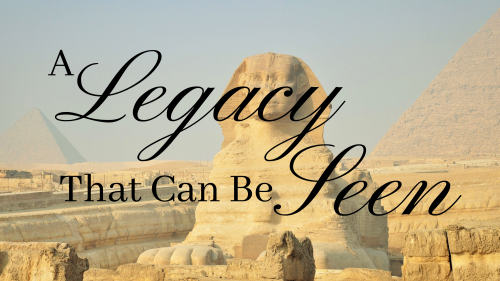
What About Your Legacy?
If you are a parent, at what point did you begin to think about the legacy you would leave your children? What kind would it be? Would it be a legacy that could be seen? Would it be financial? Would it be fond memories? If you are not a parent, who is looking up to you? Who is watching your life? What example will you set? What legacy will you leave?
In my more pensive moments as a minister, I begin to think about my own legacy. Since I had no children up until a couple of years ago, I would consider the end of my days here on earth. Then I asked myself, “Has anyone’s life been positively affected because of my life?” It’s a sobering thought.
By the way, it introduces an amazing adventure when suddenly you have 4 wonderful children and 5 fantastic grandchildren in the space of a couple of “I do’s” and a “I pronounce you…”
The Pitfall of a Legacy That Can Be Seen
Many might be cautious about a legacy that can be seen. A poem we learned in school, illustrates this. Perhaps you also remember it.
Ozymandias
by Percy Bysshe Shelley
I met a traveller from an antique land,
Who said—“Two vast and trunkless legs of stone
Stand in the desert. . . . Near them, on the sand,
Half sunk a shattered visage lies, whose frown,
And wrinkled lip, and sneer of cold command,
Tell that its sculptor well those passions read
Which yet survive, stamped on these lifeless things,
The hand that mocked them, and the heart that fed;
And on the pedestal, these words appear:
My name is Ozymandias, King of Kings;
Look on my Works, ye Mighty, and despair!
Nothing beside remains. Round the decay
Of that colossal Wreck, boundless and bare
The lone and level sands stretch far away.”
It’s important to remember this as we consider our legacy. The boastful or proud “I” will probably not create a lasting one. Nor will it likely be a positive one.
The Truth of a Lasting Legacy
But God’s Word speaks of a legacy that can be seen.
The story comes from the Bible book of Joshua, chapter 4. Finally, the people of Israel are about to enter the Promised Land. They’ve been wandering in the wilderness for 40 years as a result of their earlier stubborn rebellion. Moses, Aaron, and all but two men twenty years old or older at that time have died. Now, only Joshua and Caleb are left, simply because they were faithful in their witness to God’s provision and His mighty hand.
Just as they did so many years ago, they stand at a body of water they must cross. Once again, God will cause the waters to part so the people could go through on dry ground. The first time involved the rod of Moses, this time it will be the feet of priests carrying the Ark of the Covenant. But now God wants a memorial of the event. At His command Joshua sets apart 12 men to gather 12 stones from the river bed and set them up on the riverside in the promised land. Then, they carry 12 stones from the promised land to set in the riverbed.
Why? “This shall be a sign among you; when your children ask later, saying, ‘What do these stones mean to you?’ then you shall say to them, ‘That the waters of the Jordan were cut off before the ark of the covenant of the LORD; when it crossed the Jordan…So these stones shall become a memorial to the sons of Israel forever.” (Joshua 4:6-7 NASB) These stones became a legacy that could be seen. These stones reminded the people of God’s mighty work among them. These stones gave an opportunity to share the goodness of the Lord with the coming generations.
What Will Be Your Legacy?
So, what stones are we setting up as a memorial to God’s work in our lives?
I suggest first that our legacy would not be buildings, statues, or physical edifices. Over time these, like the statue of Ozymandias and the rocks by the river, will become mere dust.
Second, I would say that the legacy shouldn’t be about us anyway. The legacy we build in this life is best if it reminds those who come after of God. Of His greatness. Of His mercy. Of His strength. Of His love!
In fact. just a few verses later, the purpose is reiterated with an added statement.
“When your children ask their fathers in time to come, saying, ‘What are these stones?’ then you shall inform your children, saying, ‘Israel crossed this Jordan on dry ground.’ For the LORD your God dried up the waters of the Jordan before you until you had crossed, just as the LORD your God had done to the Red Sea, which He dried up before us until we had crossed; so that all the peoples of the earth may know that the hand of the LORD is mighty, so that you may fear the LORD your God forever.” (Joshua 4:21-24 NASB; emphasis added.)
Yes, it’s all about God and what He has done for us. Why? To remind us that God is at work now and into our future. He’s working in us to bring about His glory. So, when we face situations in our lives, let’s look at the stones our forefathers set up and remember what God has done. Then, let’s pick up some stones to remind us of God’s faithfulness today. Finally, set them up as a legacy that can be seen by our children.
Hymn: A Legacy That Will Be Seen
1. While passing through this world of sin,
And others your life shall view,
Be clean and pure without, within,
Let others see Jesus in you.
2. Your life’s a book before their eyes,
They’re reading it through and through;
Say, does it point them to the skies,
Do others see Jesus in you?
3. What joy ’twill be at set of sun,
In mansions beyond the blue,
To find some souls that you have won;
Let others see Jesus in you.
4. Then live for Christ both day and night,
Be faithful, be brave, and true,
And lead the lost to life and light;
Let others see Jesus in you.
Refrain:
Let others see Jesus in you,
Let others see Jesus in you;
Keep telling the story, be faithful and true,
Let others see Jesus in you.
“Let Others See Jesus in You” by B.B. McKinney (Public Domain)
Blessings,
Richard
If you found this article encouraging and inspiring, let me suggest another article about Joshua as he led the people into the Promised Land – Which Side Is God On?
You can read the poem Ozymandias at The Poetry Foundation. You can read about the poem at Wikipedia.
